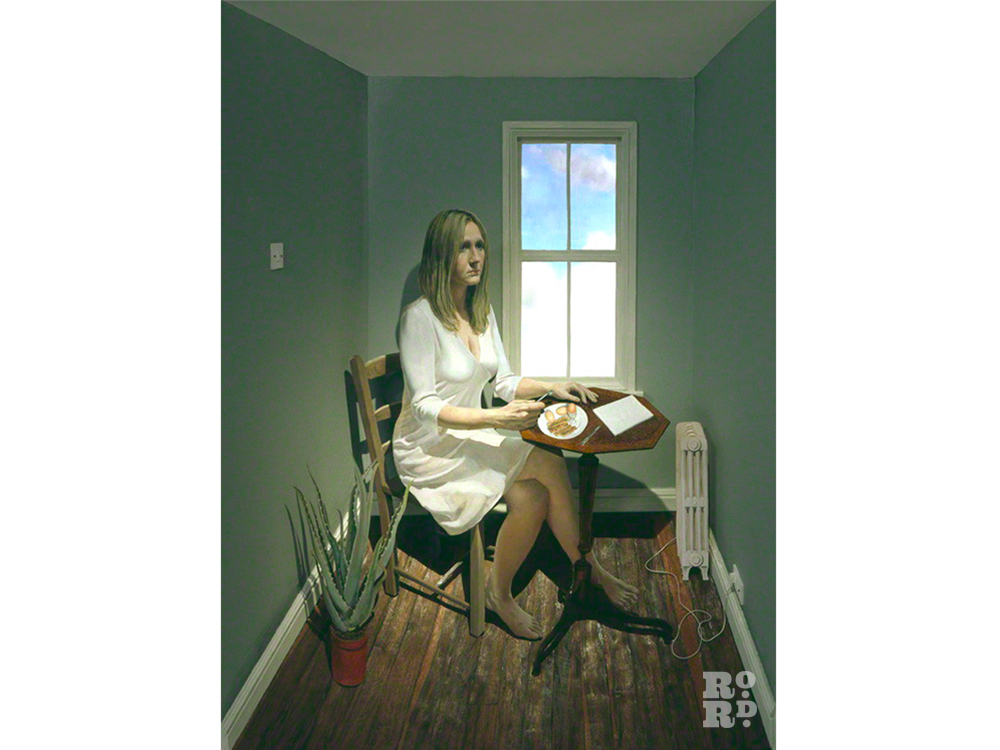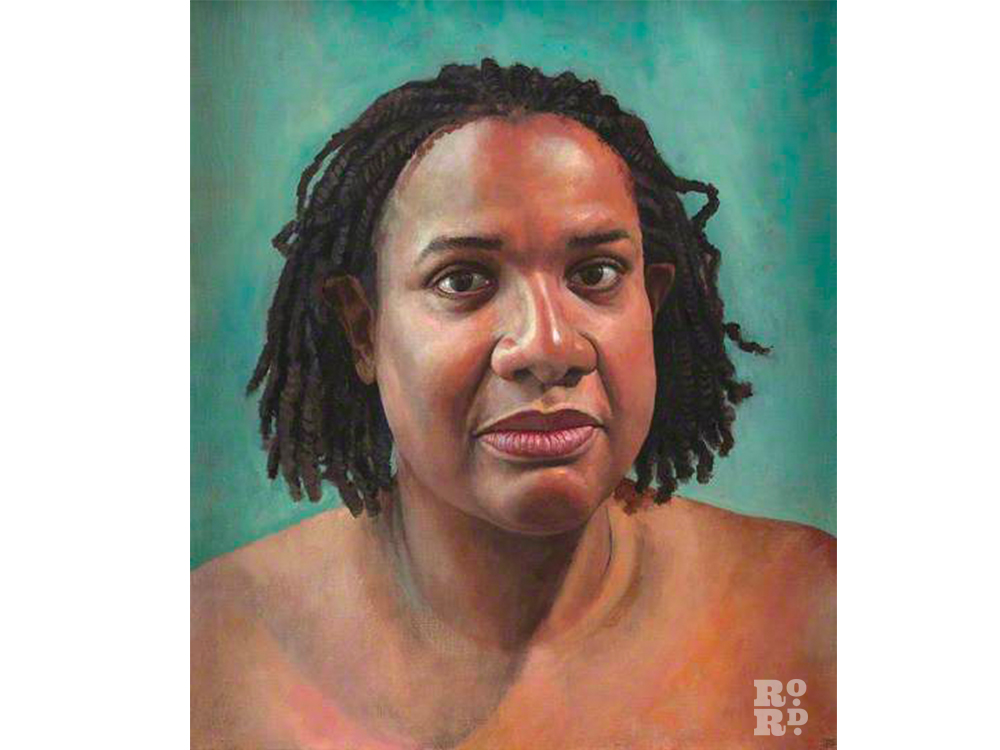Stuart Pearson Wright interview
We talk to former Roman Road resident, the portrait painter Stuart Pearson Wright, who was inspired by The Roman’s everyday people and unwittingly embroiled in the furore surrounding the portrait of MP Diane Abbott. Here Pearson Wright talks about Roman Road and JK Rowling.

Artist Stuart Pearson Wright was once described by a critic as ‘a Hogarth for our times’, and if that was so, his ‘modern moral subjects’ were the people of Roman Road.
Stuart moved into a ‘disgusting, derelict former sweatshop’ above the market, which he converted into a flat and studio space, in 2001.
‘When I first moved in I became very engaged with working with the area as a subject,’ he says. ‘I had a very ambitious idea to do this really large street scene of Roman Road.’
He hired a scaffolding tower and spent about two months doing drawings of shop fronts and market stalls, ‘and then I started trying to people the painting with people from the street.’
‘I kept asking people to come and sit for a drawing. I put an ad up in the local post office, but I think most people probably assumed I was a nutter. It was really difficult pestering people – this was around 2001-2002 – most people weren’t familiar with artists. They gave ambivalent responses, blanked me or ran in the other direction.’
Structuring his day around models that lost interest and didn’t show up left Stuart ‘so frustrated that I aborted the project.’
‘It was annoying (because) I was really inspired, initially. Roman Road felt like a real place, a raw place, untouched by this swathe of gentrification spreading across Clerkenwell and Hoxton. It felt a bit like the Wild West. It was quite a lively place. Whenever I heard a scream I’d look out the window and someone was having their head smashed against the awnings of a shop or being beaten with a chain; it was quite rough and ready.
‘It’s changing now. In five years time the street will be full of Bugaboos and flat whites and a very middle class demographic. That wasn’t what it was like when I turned up, which was part of the appeal.
‘When I first moved there it was very ‘East End’. There was a place that sold faggots, savaloys, pickled gherkins… I was quite excited about that. There were two pie and mash shops and sometimes they’d have queues outside. But then one of them closed down. I suppose the need for it diminished as all the fried chicken shops moved in.
‘I have really mixed feelings about Roman Road now. I always felt that if I’d had a say in what was going on, if I was on the council, I would’ve limited the number of fried chicken shops and betting shops, which give the street a slightly sordid image. I had a certain idea of what it could be like with some careful council control over things, and it never quite met my estimates.
‘But having said that, it was a great location as far as its proximity to the park and canal. I used to go to Victoria Park every day. I guess it was those elements that weighed up against the aspects of living there that I wasn’t so keen on.’
But while the street didn’t provide the mural fodder Stuart was after, or support the sort of amenities he wanted to see, the area did contribute a subject for a rather important – albeit controversial – portrait commission.
In 2004 Stuart was asked by the House of Commons art committee to paint the MP for Hackney North and Stoke Newington, Diane Abbott. In January 2014 the press claimed that Ms Abbott had personally commissioned the portrait and paid for it using tax payer’s money.
Stuart says the media was ‘very, very badly misinformed’ and he got ‘very, very irritated by the criticism.’
‘The thing is, I don’t like MPs more than anyone else. After the expenses scandals and Blair taking us to war, I’ve felt entirely betrayed by British politicians, so I’ve become quite a-political. I have no time for British politics. But in spite of that I still recognise that whether or not I like them, they’re important public figures. In the case of Dianne Abbott – the first black MP – that’s a milestone. I feel (the portrait) was entirely justified in that sense,’ Stuart says.
‘I was asked to paint it by the House of Commons and Diane Abbott would have had nothing to do with it.’
Of the process, he says: ‘She was the one that wanted to appear naked. She was quite dictatorial in the way she wanted to be presented. It was unusual for me to deal with someone like that. Usually I would nip something like that in the bud early on, but she was quite difficult to control.’
But while he agrees that ‘sometimes I feel if you paint people’s clothes you set them in time and also set them in a class, and that detracts from reading the expression on the face,’ he says. ‘I think it’s actually a terrible painting. It’s one of the worst paintings I’ve ever made.’
A much happier and more treasured experience was that of painting J K Rowling for the National Portrait Gallery in 2005.
‘It was very interesting, I guess because she’s such a big star, such an enormous figure of our times. And because she’s such a private person too, you’ve got this very interesting dichotomy between the public reputation and personal personality. Immediately there was a quite interesting dynamic there. I just really like her and liked her story. The fact that she came from nowhere in particular, hadn’t had any affluent family background… I was drawn to the romance of the story that she got on the train and conceived this series of books and became one of the world’s most famous authors,’ he says.
Through a series of visits to her home in Scotland, Stuart made various sketches of Rowling, sometimes while she was at work, and found her to be ‘a very nice person who balanced her fame with her family life.’
‘Once when I was there at her house, she was making me some sandwiches and the door bell rang. She came back into the kitchen and said: “you mustn’t freak out, but the Prime Minister is here,” and Gordon Brown came in and she introduced me to Gordon. That’s a story that I will tell the grandchildren.
‘It was a privilege to meet someone so influential and so universally loved. It felt quite a privilege to be chosen to paint her.’
Today, Stuart lives in ‘deepest rural Suffolk,’ having moved out of his Roman Road home in January. ‘We spent the first year of my son’s life here (but) we just out-grew the flat. It’s quite a different lifestyle (in Suffolk), to say the least, and I had very mixed feelings about leaving,’ he says. But family had to come first.
‘Painting is important, but it’s not as important as my family.’
Reflecting on the Hogarth comparison, he says: ‘It was very flattering. I remember reading that and I felt it was fairly valid because the work I was doing at the time, there was an element of social satire to it. (But) I don’t think anyone would say it now.’
‘I don’t know really where I am in the art world right now, if anywhere. I think that’s for other people to determine. I feel I haven’t made my best work yet. I feel like I’m working up to it. I just hope I work out how to make it before I become a provincial middle-aged gardener.’

